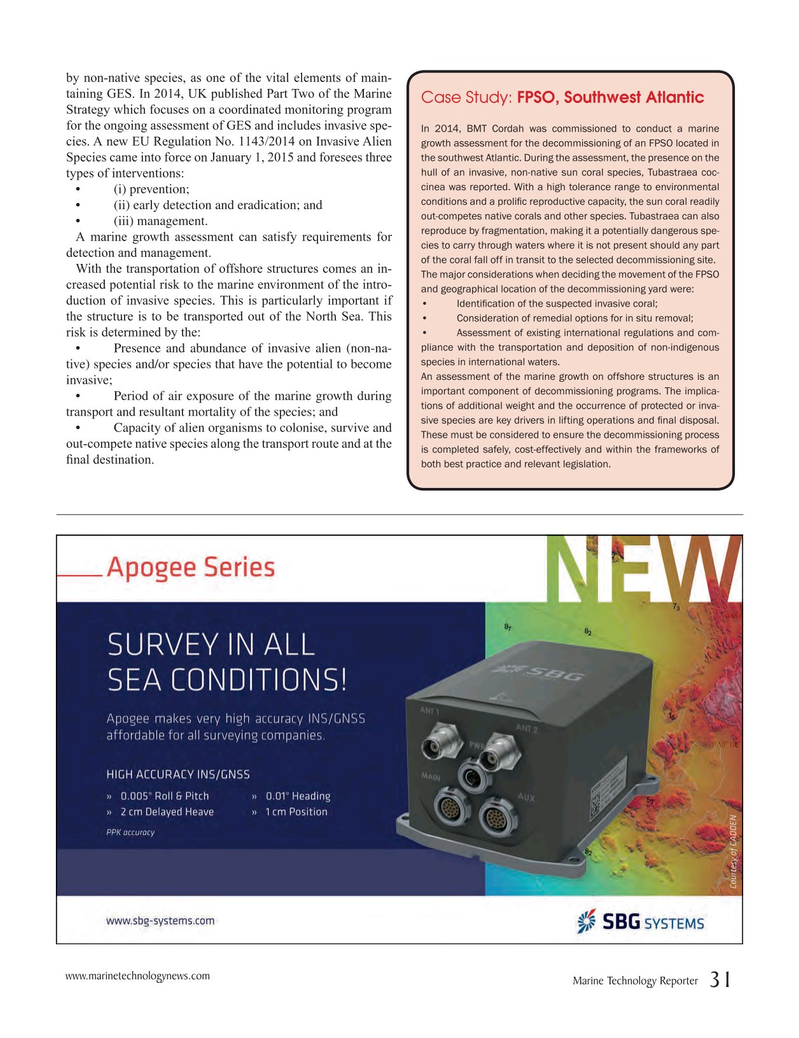
Page 31: of Marine Technology Magazine (November 2015)
Read this page in Pdf, Flash or Html5 edition of November 2015 Marine Technology Magazine
by non-native species, as one of the vital elements of main- taining GES. In 2014, UK published Part Two of the Marine
Case Study: FPSO, Southwest Atlantic
Strategy which focuses on a coordinated monitoring program for the ongoing assessment of GES and includes invasive spe-
In 2014, BMT Cordah was commissioned to conduct a marine cies. A new EU Regulation No. 1143/2014 on Invasive Alien growth assessment for the decommissioning of an FPSO located in the southwest Atlantic. During the assessment, the presence on the
Species came into force on January 1, 2015 and foresees three hull of an invasive, non-native sun coral species, Tubastraea coc- types of interventions: cinea was reported. With a high tolerance range to environmental • (i) prevention; conditions and a proli? c reproductive capacity, the sun coral readily • (ii) early detection and eradication; and out-competes native corals and other species. Tubastraea can also • (iii) management. reproduce by fragmentation, making it a potentially dangerous spe-
A marine growth assessment can satisfy requirements for cies to carry through waters where it is not present should any part detection and management.
of the coral fall off in transit to the selected decommissioning site.
With the transportation of offshore structures comes an in-
The major considerations when deciding the movement of the FPSO creased potential risk to the marine environment of the intro- and geographical location of the decommissioning yard were: duction of invasive species. This is particularly important if • Identi? cation of the suspected invasive coral; the structure is to be transported out of the North Sea. This • Consideration of remedial options for in situ removal; • Assessment of existing international regulations and com- risk is determined by the: pliance with the transportation and deposition of non-indigenous • Presence and abundance of invasive alien (non-na- species in international waters.
tive) species and/or species that have the potential to become
An assessment of the marine growth on offshore structures is an invasive; important component of decommissioning programs. The implica- • Period of air exposure of the marine growth during tions of additional weight and the occurrence of protected or inva- transport and resultant mortality of the species; and sive species are key drivers in lifting operations and ? nal disposal. • Capacity of alien organisms to colonise, survive and
These must be considered to ensure the decommissioning process out-compete native species along the transport route and at the is completed safely, cost-effectively and within the frameworks of ? nal destination.
both best practice and relevant legislation.
www.marinetechnologynews.com
Marine Technology Reporter 31
MTR #9 (18-33).indd 31 12/9/2015 11:19:39 AM

 30
30

 32
32
